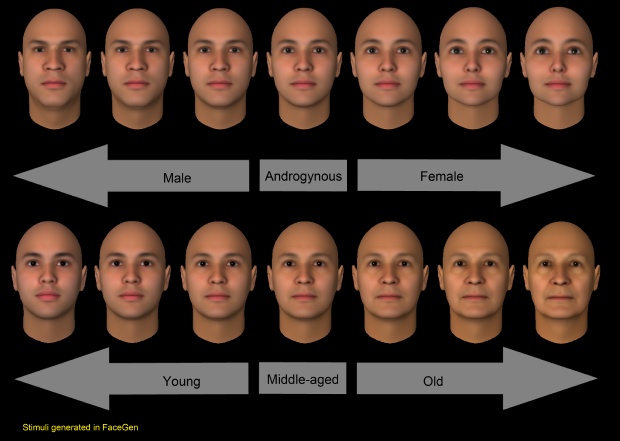In the real world, the brain's inconsistency in assigning gender to faces isn't noticeable because there are so many other clues, like hair and clothing, but when people view computer-generated faces, stripped of all other gender-identifying features, a pattern of biases based on location of the face emerges.
The researchers showed subjects a random series of faces, ranging along a spectrum of very male to very female, and asked them to classify the faces by gender. For the more androgynous faces, subjects rated the same faces as male or female, depending on where they appeared.
Study participants were told to fix their gaze at the center of the screen, as faces were flashed elsewhere on the screen for 50 milliseconds each. Assuming that the subjects sat about 22 inches from the monitor, the faces appeared to be about three-quarters of an inch tall.
The patterns of male and female biases were different for different people. That is, some people judged androgynous faces as female every time they appeared in the upper right corner, while others judged faces in that same location as male. Subjects also showed biases when judging the age of faces, but the pattern for age bias was independent from the pattern for gender bias in each individual.

Subjects in the study were shown computer-generated faces, created with FaceGen software, that ranged along a spectrum from very male to very female. Credit: Arash Afraz
Arash Afraz, a postdoctoral associate at MIT's McGovern Institute for Brain Research and lead author of a new paper on the work, believes this inconsistency in identifying genders is due to a sampling bias, which can also be seen in statistical tools such as polls. For example, if you surveyed 1,000 Bostonians, asking if they were Democrats or Republicans, you would probably get a fairly accurate representation of these percentages in the city as a whole, because the sample size is so large.
However, if you took a much smaller sample, perhaps five people who live across the street from you, you might get 100 percent Democrats, or 100 percent Republicans. "You wouldn't have any consistency, because your sample is too small," says Afraz.
He believes the same thing happens in the brain. In the visual cortex, where images are processed, cells are grouped by which part of the visual scene they analyze. Within each of those groups, there is probably a relatively small number of neurons devoted to interpreting gender of faces. The smaller the image, the fewer cells are activated, so cells that respond to female faces may dominate. In a different part of the visual cortex, cells that respond to male faces may dominate.
Citation: Arash Afraz, Maryam Vaziri Pashkam, and Patrick Cavanagh, 'Spatial Heterogeneity in the Perception of Face and Form Attributes', Current Biology, 24 November 2010 10.1016/j.cub.2010.11.017





Comments